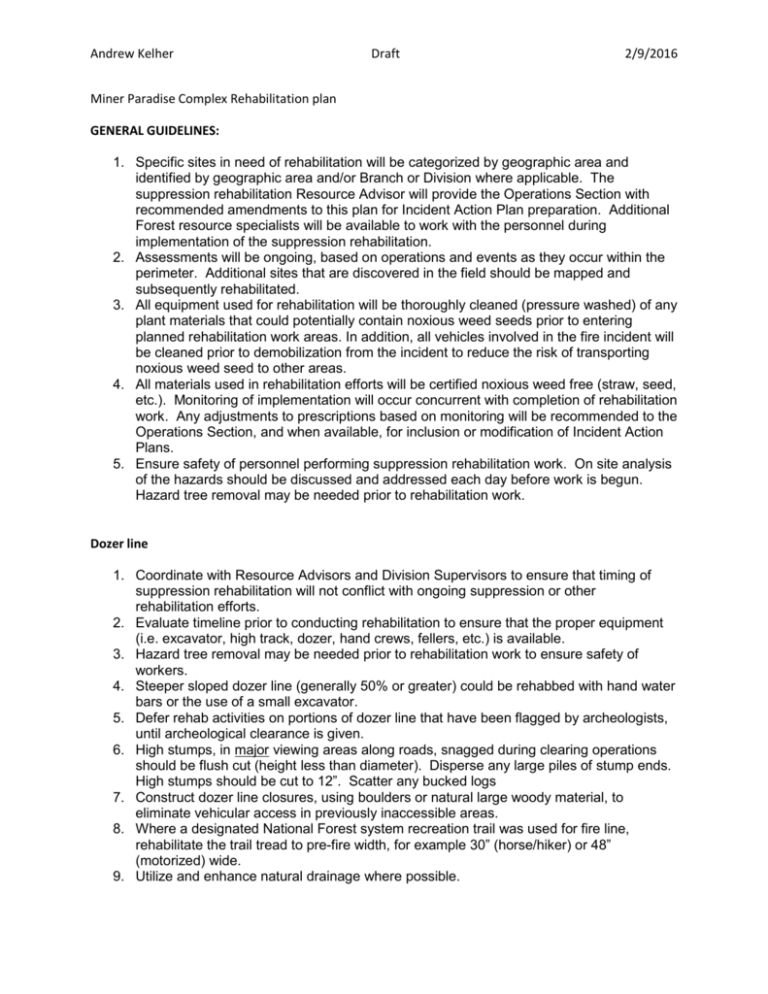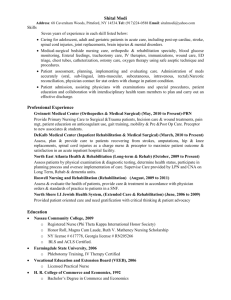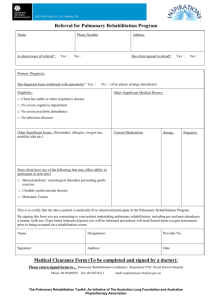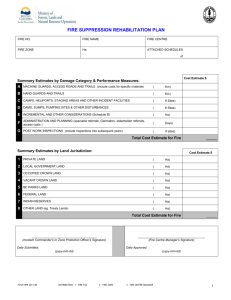Miner Paradise Complex Rehabilitation Plan
advertisement

Andrew Kelher Draft 2/9/2016 Miner Paradise Complex Rehabilitation plan GENERAL GUIDELINES: 1. Specific sites in need of rehabilitation will be categorized by geographic area and identified by geographic area and/or Branch or Division where applicable. The suppression rehabilitation Resource Advisor will provide the Operations Section with recommended amendments to this plan for Incident Action Plan preparation. Additional Forest resource specialists will be available to work with the personnel during implementation of the suppression rehabilitation. 2. Assessments will be ongoing, based on operations and events as they occur within the perimeter. Additional sites that are discovered in the field should be mapped and subsequently rehabilitated. 3. All equipment used for rehabilitation will be thoroughly cleaned (pressure washed) of any plant materials that could potentially contain noxious weed seeds prior to entering planned rehabilitation work areas. In addition, all vehicles involved in the fire incident will be cleaned prior to demobilization from the incident to reduce the risk of transporting noxious weed seed to other areas. 4. All materials used in rehabilitation efforts will be certified noxious weed free (straw, seed, etc.). Monitoring of implementation will occur concurrent with completion of rehabilitation work. Any adjustments to prescriptions based on monitoring will be recommended to the Operations Section, and when available, for inclusion or modification of Incident Action Plans. 5. Ensure safety of personnel performing suppression rehabilitation work. On site analysis of the hazards should be discussed and addressed each day before work is begun. Hazard tree removal may be needed prior to rehabilitation work. Dozer line 1. Coordinate with Resource Advisors and Division Supervisors to ensure that timing of suppression rehabilitation will not conflict with ongoing suppression or other rehabilitation efforts. 2. Evaluate timeline prior to conducting rehabilitation to ensure that the proper equipment (i.e. excavator, high track, dozer, hand crews, fellers, etc.) is available. 3. Hazard tree removal may be needed prior to rehabilitation work to ensure safety of workers. 4. Steeper sloped dozer line (generally 50% or greater) could be rehabbed with hand water bars or the use of a small excavator. 5. Defer rehab activities on portions of dozer line that have been flagged by archeologists, until archeological clearance is given. 6. High stumps, in major viewing areas along roads, snagged during clearing operations should be flush cut (height less than diameter). Disperse any large piles of stump ends. High stumps should be cut to 12”. Scatter any bucked logs 7. Construct dozer line closures, using boulders or natural large woody material, to eliminate vehicular access in previously inaccessible areas. 8. Where a designated National Forest system recreation trail was used for fire line, rehabilitate the trail tread to pre-fire width, for example 30” (horse/hiker) or 48” (motorized) wide. 9. Utilize and enhance natural drainage where possible. Andrew Kelher Draft 2/9/2016 10. Dozers are inefficient tools in the rehabilitation process to recover side cast material and can cause more disturbances if used for rehabilitation in moderately-steep to steep terrain and in timbered vegetation types. For this reason, dozers should only be used to perform final construction of water bars on the dozer line, followed by an excavator and/or a heavy-duty backhoe to pull berms and redistribute side cast fills and woody debris. If large rock is to be moved to facilitate dozer line reshaping or re-establishment of road closures then a bucket with an opposable thumb should be used with the excavator. 11. Water Bar Guidelines a. Cut the water bar into solid soil with a depth of at least 12 inches b. Shape the berm, parallel to the cut, at least twelve inches above the line grade. c. The discharge slope should not exceed 2% for water bars. d. Construct the cut downward, but not more than 45 degree angle, so water runs to the outlet. e. Steeper pitched water bar outlets should have runoff energy dissipaters; do not plug outlet. Use available logs, boulders, slash, etc. as energy dissipators. f. Where possible, consider alternating drainage direction to visually break up the linear features of dozer lines and to reduce hydrologic head of runoff g. Utilize existing slope breaks and barriers as water bars whenever possible. If not available, construct water bars with a spacing interval as follows: i. 5-10% slope, water bar every 80 feet ii. 11-25% slope, water bar every 40 feet iii. 25% and greater slope, water bar every 25 feet iv. General Rule of Thumb for water bar intervals: As a guideline, when standing in last constructed water bar, next water bar to be constructed should be at eye level on fire line. 12. Steeper sloped dozer line could be rehabbed with hand water bars and seeding. Hand line water bars should be 8” deep and 12-18” high for the berm. On slopes >30%, waterbars should be installed angled down 20-30 degrees to the fall line. 13. If soil is loose, augment water bar with woody debris and/or rocks. 14. In special circumstances on highly erosive soils, straw matting, may be necessary. Sites deemed too steep for dozer water bars must be covered with slash. Coconut straw erosion matting (or similar matting) will also be used on steeper line where there is insufficient slash available. If straw bales are used as erosion barriers, they must be certified weed seed free. 15. Additional drainage holes should be punched through berm on line. 16. Remove all flagging, trash and temporary signs. 17. Control lines in areas less than 5 % slope, should be rolled back to eliminate berms 18. Control lines should have berms raked and spread over the line and line nautralized by scattering available material (brush, logs) over them, where available. 19. Trenching created by dozers will be filled to approximate natural contours and naturalized. Control lines with a cut slope would have the fill slope pulled up and down slope cut to approximate the natural contours and naturalized. 20. Fire line or dozer lines that intersect main roads will be naturalized and camouflaged. 21. Trees that have burned and fallen will be left in place unless they obstruct a road template. Hazard trees to state and county roads will be felled. If necessary, additional funding outside of fire suppression funds may be acquired to pile and burn felled material this winter.. 22. When water bars with logs on dozer lines are to be constructed, the preferred size of logs are 6 to 8” DBH and long enough to cover the width of the dozer line with the largest diameter down hill. If smaller size logs are used and/or soil is very loose and Andrew Kelher Draft 2/9/2016 powdery, increase the number of water bars and include them on gentler slopes. If substrate is all or mostly rock, water bars should be placed below the rocky areas. Fire Location Emigrant Fire Emigrant Gulch Starting at DP 10 Emigrant Fire Division Kilo starting at DP19 going north Emigrant Fire Division Kilo starting at DP19 going south Emigrant Fire Division Kilo, From H-8 to wilderness boundary Emigrant Fire Division Kilo, From wilderness boundary to division lima boundary Emigrant Fire Gold Prize Sheep Green mile line Sheep Section 15 by Helispot A2T2 Rehab notes 1. Replace rock barriers with an excavator 2. Post no motorized travel signs to prevent ATV and Dirt bike use 1. Post no motorized travel signs to prevent ATV and Dirt bike use at bottom of line where it ties into red Mountain Road. Section 17 and 8 swsw 2. Reseed with desired seed mix from BLM or state as provided and needed 3. Water bar steep section on line section 17 and swsw 8 1. Reseed with desired seed mix from BLM or state as provided and needed 1. Steep potion section 17 sw, should be watered bared 1. Creek crossing need stream bank work to stabilize, 2. Pumps and hoses need removed and 3. Restore water source used for pumps Post for no motorized travel. 1. Berms broken up and pulled back 2. Open meadows need special attention, covered back with duff and top soil, reseeded. 3. Clean equipment before use to prevent thistle spread on to FS land. Drainage and pulling back. Steep slope, recommended to bedone Andrew Kelher Draft Sheep DP-5 to clearcut Sheep Road to upper pumpkin 2/9/2016 with minmal tool as possible All water crossing, dry creek beds included need reopened 1. Road need deconstructed 2. walking and horse trail from state land that road crosses should be keep clear and brought back to standard 3. Knapweed in area, needs to treated Hand Line 2. Pull in berms. 3. Hazard tree removal may be needed prior to rehabilitation work to ensure safety of workers. 4. Where a designated National Forest system recreation trail was used for fire line, reconstruct the trail tread to the pre-fire width, for example 24” (horse/hiker) or 48” (motorized) wide. 5. In forest types, naturalize or partially obliterate fire lines with logs, litter, or other material if available. 6. Remove all flagging, temporary signs and trash 7. Utilize existing slope breaks and barriers as water bars whenever possible. If not available, construct hand water bars with a spacing interval as follows 8. 0-20% slope, water bar every 66 feet 9. 20-40% slope, water bar every 30 feet 10. 40% and greater, closer spacing as needed. Bottom of uphill bar should be approximately level with top of next water bar downhill. 11. Water bars should be approximately at a 30-45 degree angle and must drain freely. Fire Location Rehab notes Emigrant Division India Emigrant Division India Sheep Top of clear cut running SW to NE Sheep End of green mile dozer line Section sw 34 near emigrant ridge line needs berms pulled back and steep parts need water bars. Line on section between 33 and 34 following gold prize creek, line needs deconstructed All needs to be water bared and pulled back. SW corner needing most work. 200 yards of line need water bars, pulled back Andrew Kelher Draft 2/9/2016 FACILITIES: Camps (Base and Spike), Helispots, Drop Points, Staging Areas, Safety Zones, Pumping Stations, Etc: 1. For lands with land use agreements, rehabilitate as specified in the land use agreement. 2. As crews are demobilized assure that the campsites, heliports/helispots, drop points, and staging areas are clean and naturalized. This should be checked and confirmed before release. 3. Remove all temporary facilities. 4. Install water bars or drainage features as appropriate. 5. Replace or repair any facilities (i.e. culverts, cattleguards, fences, etc.) crushed or damaged as a result of fire suppression activities. 6. Remove all temporary fire communications lines. 7. Remove all flagging, litter and signs. 8. Safety Zones should be rolled back to eliminate berms 9. Rip or loosen compacted surfaces as identified by Resource Advisors. 10. Contaminated soils should be removed and disposed of in approved hazardous waste disposal site. 11. Clean ditches and culverts filled with debris or soil as a result of road widening. 12. Restore all water sources that were used to supply hose lays, tenders, and engines during the suppression efforts. 13. Remove any dams or other devices used to pool water and all litter, trash, and flagging. 14. Install wattles and/or coconut matting on impacted portions of stream banks (generally where pumping stations have been). 15. Disperse felled/downed trees and brush evenly in areas where they had been pushed aside. 16. Remove hazardous material containment pads and dispose of properly. 17. Restore natural contour and seed all disturbed sites Fire Emigrant Fire Location Jumper camp at H3 Emigrant Fire- Gulf Spike Emigrant Gulch Rehab notes 1. Fire pits have trash in them and ashes need picked up or buried and covered with slash/. 2. On the north side of the creek, completely cover the area with slash to discourage any ATV or motorcycle use. 3. Remove log Foot Bridges and scatter cribbing rocks. 4. Remove all fire rock rings scatter rocks. 5. Fill in and cover fire pits. 6. Cover with slash all walking paths created in camp 7. Remove all fire related equipment. Andrew Kelher Draft Emigrant fire Base Camp Emigrant orginal site Miner Paradise Base Camp Horse tail Chisum spike Emigrant Fire Drop points along 6 mile road Sheep DP 15 Sheep Med spot A1 and T2 2/9/2016 8. Remove all flagging and trash. 9. Fill in and cover with slash all latrines and break and scatter any structure constructed Reseed with desired seed mix of FWP and State lands Reseed with desired seed mix of FWP and State lands Meet the standards of the local district campground host. Parking location need riped and reseeded from compaction from Parking and use Compact soil needs riped and seeded Used as parking location, compacted soil needs ripped and reseeded. ROADS: All roads used for fire suppression activities shall have the following work items completed. 1. All snags/hazard trees that pose a hazard to suppression rehabilitation crew safety shall be cut within one tree length of the road. Lop and scatter material. 2. Remove all flagging, litter and signs. 3. Re-establish ephemeral drainage at crossings. 4. Clean all drainage structures including catch basins, culvert outlets, ditches, and outlet ditches. 5. Blade out all berms ensuring drainage is not obstructed. Utilize berm material to fill in ruts where feasible. 6. Re-establish inter visible turnouts at vertical crests and horizontal curves. 7. Lay back all disturbed vertical cut slopes to a 1:1 slope where feasible. 8. Reestablish rolling dips (grade reversal/drivable dip) and outlet ditches. Locate dips at locations that will remove water from the road at increments that keep the quantity and velocity low. On steeper grades rolling dips shall be located at a minimum midway down the slope. On extended long grades rolling dips shall be placed at a maximum of 500 feet apart. Locate outlet ditches to ensure proper drainage away from the road. 9. Where two roads have been established for short lengths pick the best route to keep and obliterate the other by ripping and seeding. Andrew Kelher Draft 2/9/2016 WATER COURSE CROSSINGS: 1. Restore stream banks impacted by suppression activities using coconut fiber wrap or log to reform banks as specified by the Suppression Resource Advisor. 2. Remove all fill, downed trees and/or debris used as bridges, or other material from stream channels down to natural stream bottom outside of the drainage-way, where dozers have gone across streams or riparian areas. 3. Do not try to fill in channel banks (loose material will wash away). 4. Stockpile removed fill in stable locations outside of the active channel and preferable within a previously disturbed area where it will not erode back into the stream. 5. Construct “cutoff” water bars at logical sites above both sides of the crossing where runoff can be diverted onto non-erodible materials and dissipated before it reaches the channel. 6. Where fire line approaches are composed of erodible materials or runoff from above that cannot be diverted, stabilize the exposed surface with mulching, erosion control blanket, and seed with appropriate seed listed in this plan. 7. Minimize additional damage to riparian vegetation and disturbance to soils. Take extra precaution in these areas to not further damage riparian areas. 8. Remove debris from culverts that have been blocked or made ineffective due to suppression efforts. SEEDING: All suppression rehabilitation sites1 requiring seed will use the following mixes, (for broadcast treatment)2. Reseeding of all fire line will take place to prevent the spread of noxious weeds, control erosion and prevent the likelihood of a dozer line becoming a “new road”. Subject to availability, a species might need to be substituted or the mix reconfigured. The mix must be certified weed seed free: Certified, blue-tagged seed shall be used where a name variety or cultivar is specified. Blue tags, that are removed to mix or spread the seed will be saved and provided to the Forest Service. MOISTER AREAS / MID TO HIGHER ELEVATIONS3 PLS (lbs/ac) Common name & variety Scientific name Broadcast Mountain Brome (bromar) Canby Bluegrass (canbar) Big Bluegrass(sherman) Slender Wheatgrass (pryor) Idaho (joseph) Total Pure Live Seed lbs/acre* Bromus marginatus Poa canbyi Poa ampla Agropyron trachycaulum Festuca idahoensis 10 lbs/ac 2 lbs/ac 2 lbs/ac 7 lbs/ac 2 lbs/ac 23 lbs/ac 1 Seeding under this plan applies to fire suppression rehabilitation only (i.e. dozer lines, hand lines, helispots, other appropriate facilities) and not for any identified BAER seed treatment prescriptions that might occur later. 2 The above species are considered native to the area. Mix recommendation - USDA-Bridger, MT Plant Material Center, Mark Majerus. 3 Generally over 6000 foot elevation, dependent upon matching up with species located in the rehabilitation area. Andrew Kelher Draft 2/9/2016 DRIER AREAS / LOWER ELEVATION4 Common name & variety Scientific name PLS (lbs/ac) Broadcast Green Needlegrass (lodorm) Slender Wheatgrass (pryor) Bluebunch Wheatgrass (goldar, anatone or whitmar) Idaho (joseph) or Big Bluegrass (sherman) Sandberg Bluegrass Total Pure Live Seed lbs/acre* Stipa viridula Agropyron trachycaulum Agropyron spicatum 6 lbs/ac 6 lbs/ac 6 lbs/ac Festuca idahoensis Poa ampla Poa sandbergii 1 lbs/ac 1 lbs/ac 1 lbs/ac 21 lbs/ac RANGE IMPROVEMENTS / NOXIOUS WEEDS: All fences or other rangeland improvements damaged by fire suppression activities (i.e. fences cut to get crews or equipment into areas; pipelines, cattleguards, gates, or culverts damaged by equipment, etc.) are to be repaired or replaced (minor repair/replacement) where suppression impacts occurred, depending upon the degree of damage. Available Crews could accomplish this work. Fire suppression activities (e.g., fire lines - especially dozer lines, equipment landings, and drop zones) can expose mineral soil that presents significant risk of new or greatly expanded weeds invasions. To minimize weed spread on fire suppression activity areas: 4 Replace side cast duff, litter, and slash to reduce the surface area of exposed mineral soil. (Duff contains seeds of native plants that can inhibit weed spread.) Ground-based broadcast seeding on mineral soil can be effective in reducing new weeds invasions, especially where there is no duff/litter to replace on the disturbed sites. Seeding may also be combined with duff/slash replacement. Use seed mixes and prescription outlined in this plan. Generally under 6000 foot elevation, dependent upon matching up with species located in the rehabilitation area.






